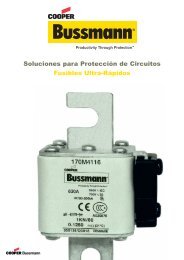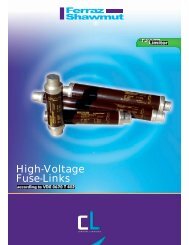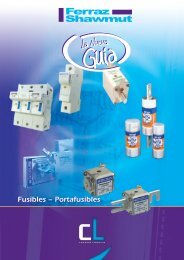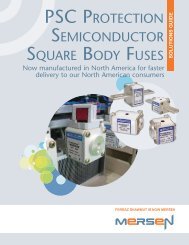Bussmann
Create successful ePaper yourself
Turn your PDF publications into a flip-book with our unique Google optimized e-Paper software.
Fuse Technology<br />
<strong>Bussmann</strong> ®<br />
Operating Principles of <strong>Bussmann</strong> ®<br />
Fuses<br />
The principles of operation of the modern, current-limiting Buss<br />
fuses are covered in the following paragraphs.<br />
Non-Time-Delay Fuses<br />
The basic component of a fuse is the link. Depending upon the<br />
ampere rating of the fuse, the single-element fuse may have one<br />
or more links. They are electrically connected to the end blades (or<br />
ferrules) (see Figure 1) and enclosed in a tube or cartridge surrounded<br />
by an arc quenching filler material. BUSS ® LIMITRON ®<br />
and T-TRON ® fuses are both single-element fuses.<br />
Under normal operation, when the fuse is operating at or near its<br />
ampere rating, it simply functions as a conductor. However, as<br />
illustrated in Figure 2, if an overload current occurs and persists for<br />
more than a short interval of time, the temperature of the link eventually<br />
reaches a level which causes a restricted segment of the link<br />
to melt. As a result, a gap is formed and an electric arc established.<br />
However, as the arc causes the link metal to burn back, the<br />
gap becomes progressively larger. Electrical resistance of the arc<br />
eventually reaches such a high level that the arc cannot be sustained<br />
and is extinguished. The fuse will have then completely cut<br />
off all current flow in the circuit. Suppression or quenching of the<br />
arc is accelerated by the filler material. (See Figure 3.)<br />
Single-element fuses of present day design have a very high<br />
speed of response to overcurrents. They provide excellent shortcircuit<br />
component protection. However, temporary, harmless<br />
overloads or surge currents may cause nuisance openings unless<br />
these fuses are oversized. They are best used, therefore, in circuits<br />
not subject to heavy transient surge currents and the temporary<br />
over-load of circuits with inductive loads such as motors,<br />
transformers, solenoids, etc. Because single-element, fast-acting<br />
fuses such as LIMITRON and T-TRON fuses have a high speed of<br />
response to short-circuit currents, they are particularly suited for<br />
the protection of circuit breakers with low interrupting ratings.<br />
Whereas an overload current normally falls between one and<br />
six times normal current, short-circuit currents are quite high.<br />
The fuse may be subjected to short-circuit currents of 30,000<br />
or 40,000A or higher. Response of current limiting fuses to such<br />
currents is extremely fast. The restricted sections of the fuse link<br />
will simultaneously melt (within a matter of two or three-thousandths<br />
of a second in the event of a high-level fault current).<br />
The high total resistance of the multiple arcs, together with the<br />
quenching effects of the filler particles, results in rapid arc suppression<br />
and clearing of the circuit. (Refer to Figures 4 & 5) Shortcircuit<br />
current is cut off in less than a half-cycle, long before the<br />
short-circuit current can reach its full value (fuse operating in its<br />
current limiting range).<br />
Figure 1. Cutaway view of typical single-element fuse.<br />
Figure 2. Under sustained overload, a section of the link melts and an<br />
arc is established.<br />
Figure 3. The “open” single-element fuse after opening a circuit<br />
overload.<br />
Figure 4. When subjected to a short-circuit current, several<br />
sections of the fuse link melt almost instantly.<br />
Figure 5. The “open” single-element fuse after opening a short circuit.<br />
212






